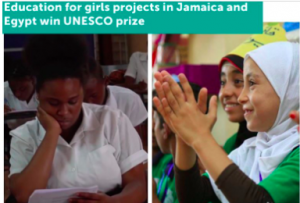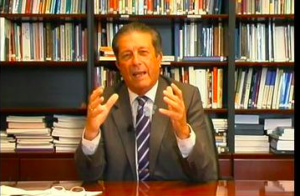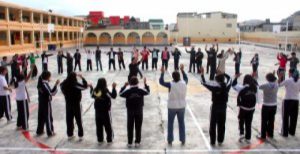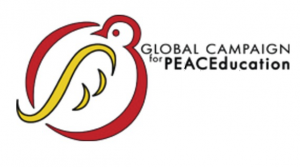
Here are the CPNN articles on this subject:
Mexico: Curricular Strategy on Gender Equality to be implemented in public schools
Education for girls projects in Jamaica and Egypt win UNESCO prize
Day of the Girl Child — Writings by Afghan women

To begin this discussion, see the videos from three people who first developed the culture of peace concept at UNESCO and the United Nations, Federico Mayor Zaragoza, Anwarul Chowdhury and David Adams:
This discussion question applies to the following articles:
Johan Galtung: The Fall of the US Empire
Culture of Peace: Interview with Mr. Federico Mayor Zaragoza, ex-Director-General of UNESCO
The Secret of the 5 Powers – A documentary about nonviolent heroes
Federico Mayor: Culture of Peace

Dr. Ada Aharoni, the founder of IFLAC considers that through poetry, people from both sides of conflicts, might come to understand each other better, and that this understanding can lead to the promotion of peace, as she explains below:
THE POWER OF THE POEM AND PEACE THROUGH POETRY
“The real profound difference between human beings is their Culture: mainly, their Cultural Heritage, Literature, Poetry, Language, Values, Norms, Traditions and their History. In the case of people in long conflicts – like the Israelis and Palestinians – feelings of fear, mistrust and lack of understanding have been piling up in their hearts and minds over the years, on both sides.
Only a suitable vehicle that can reach and profoundly penetrate through those layers of mistrust, suspicion and fear, can overcome those separating boundaries and build bridges of trust and respect for each other’s humanity. The best vehicle for this delicate operation is the magic and healing of the Poem, with its words of comprehension, feelings, care and tenderness. The poem has the marvellous ability to create bridges of trust and love.
Peace Poetry can also impart the important and crucial message that we all belong to one family, the family of humanity, and that violence and terror only lead to chaos, destruction, sorrow and deep pain and misery on all sides.
In every conflict there are two stories. The Poem of Peace, because of its wonderful ability to present both sides in all its reality, pain, hope and yearning for peace – can lead to mutual recognition and reconciliation, and to the building of confidence, trust, respect and love.”
World Movement of Poetry: for the Culture of Peace
From Madagascar: Identity specificity and civilization of the universal
IFLAC World Peace Festival : First edition in Argentina
Hall’s poetry about more than ‘black history
Gwangju, Korea: The 1st Asian Literature Festival
Une jeune malienne de 15 ans gagne le concours des « Chemins de la culture de la paix »
Young Malian aged 15 wins “Pathways to a Culture of Peace”> contest

Here are some films and videos recommended by our readers.
Film review: Oliver Stone’s new JFK documentary
Film from South Africa: Everything Must Fall
Pre-screening of the film “The Forgiven” starring Forest Whitaker at UNESCO
Film: Truth, Deception and the Spirit of I.F. Stone
Film review: Disturbing the Peace
Snowden: Best Film of the Year
Documentary Review: “Where to Invade Next” by Michael Moore
Edward Snowden Congratulates Laura Poitras for Winning Best Documentary Oscar for Citizenfour
WACC-SIGNIS Human Rights Award 2013 Goes to “Caminhos da paz”
PLURAL+ 2012 Youth Video Festival on Migration and Social Inclusion
Projet de festival international de marionnettes
Interfaith Jury Awards ‘The Orange Suit’ in Fajr International Film Festival
Black International Cinema Berlin: May 2-6, 2012
Rio+20 Global Youth Music Contes
Fourth Contest of Animations for Peace

The following comes from the website of Signis, World Catholic Organization for Communication – Media for a Culture of Peace. They sponsor a number of film festivals around the world which emphasize the culture of peace.
Every day the media bring us more news of conflict, acts of terrorism, massacres, racism or xenophobia. It seems that we are drowning in a culture of hatred and war.
Let’s imagine instead for a moment that the world’s radio and TV stations were reporting on, and devoting a significant part of their programmes and broadcasts to gestures of reconciliation and acts of peacemaking. So alongside the culture of violence and war, which, of course, we cannot ignore, because it is part of what makes us human, they would develop in the media a Culture of Peace.
This does not have to remain only a dream. If every member of SIGNIS, radio, video and television producer, webmaster, educator, researcher and trainer, got involved in making programmes on those acts which are contributing to peace and in promoting gestures of reconciliation… all of us would have helped to increase the possibilities of helping to make the world a more peaceful place.
That is why the SIGNIS delegates, during their meeting in Cape Town in 2003, choose as the main objective for SIGNIS to work to promote a Culture of Peace through the media.
Colombia: Cinema, historical memory and culture of peace
28TH FESPACO: Gold for Tunisia and silver for Burkina
Fifteen films bid for top prize in Africa’s premiere film fest
Spain : Films for peace – ten years of MUSOC
The Páramo de Sumapaz, will be the scene of Colombian cinema festival
Brazil: Ecocine International Film Festival of Environmental and Human Rights
Mexico: Second Edition of the International Festival of Cinema for the Culture of Peace
MADRID: Fifth edition of the Film and Human Rights Festival
Burkina Faso: Blanche Bana wins the Sotigui Awards 2020
Iranian film “Castle of Dreams” wins at Religion Today filmfest in Italy
Xalapa, Mexico: International Film Festival for a Culture of Peace
Korea: Busan Film Festival and creation of world culture
Challenge in Colombia: Peace displacing violence as inspiration for the arts
Bridging the gap- -International documentary film festival
Taguatinga Film Festival accepting registration until the 30th ( Brazil )
Festival Taguatinga de Cinema tem inscrições abertas até o dia 30 (Brasil)
Human Rights Watch film festivals: Toronto and London
FESPACO 2013 : Preparations for an Excellent Festival of African Cinema
FESPACO 2013 : Des dispositions pour une belle fête du cinéma africain
International Festival of Nyamina, Mali: Cinema and Peace
Festival international de Nyamina, Mali : Cinéma et paix

As described in the book by Dietrich Fischer listed in the right column, Johan Galtung is indeed the most perceptive peace researcher of our time.
Not only did he predict the fall of the Soviet Union quite precisely, but he has also predicted the fall of the American empire. Here are excerpts from his 2004 article, On the Coming Decline and Fall of the US Empire.
The prediction of the decline and fall of the US Empire is based on the synergy of 14 contradictions, and the time span for the contradictions to work their way through decline to fall was estimated at 25 years in the year 2000. There are more contradictions because the US Empire is more complex, and the time span is longer also because it is more sophisticated. After the first months of President George W. Bush (selected) the time span was reduced to 20 years because of the way in which he sharpened so many of the contradictions posited the year before, and because his extreme singlemindedness made him blind to the negative, complex synergies. . . .
(Editor’s note: As of 2018, Professor Galtung holds to his prediction that the American Empire cannot be maintained beyond 2020: “Trump contributes by making USA an impossible leader to follow. As long as he is in command–and nobody knows how long that will last, before he is removed by impeachment, Amendment 25, or the old US tradition of killing inconvenient presidents–rebuilding the US empire is difficult. . . . In short, I stand by my prediction that by Year 2020 the US empire is gone.”)
Here is the list of 14 contradictions posited in 2000:
I. Economic Contradictions(US led system WB/IMF/WTO NYSE Pentagon)
1. between growth and distribution: overproduction relative to demand, 1.4 billion below $ 1/day, 100.000 die/day, 1/4 of hunger
2. between productive and finance economy (currency, stocks,bonds) overvalued, hence crashes, unemployment, contract work
3. between production/distribution/consumption and nature: ecocrisis, depletion/pollution, global warming
II. Military Contradictions (US led system NATO/TIAP/USA-Japan)
4. between US state terrorism and terrorism: Blowback
5. between US and allies (except UK, D, Japan), saying enough
6. between US hegemony in Eurasia and the Russia India China triangle, with 40% of humanity
7. between US led NATO and EU army: The Tindemans follow-up
III. Political Contradictions (US exceptionalism under God)
8. between USA and the UN: The UN hitting back
9. between USA and the EU: vying for Orthodox/Muslim support
IV. Cultural Contradictions (US triumphant plebeian culture)
10. between US Judeo-Christianity and Islam (25% of humanity; UNSC nucleus has four Christian and none of the 56 Muslim countries).
11. between US and the oldest civilizations (Chinese, Indian, Mesopotamian, Aztec/Inca/Maya)
12. between US and European elite culture: France, Germany, etc.
V. Social Contradictions (US led world elites vs the rest: World Economic Forum, Davos vs World Social Forum, Porto Alegre)
13. between state corporate elites and working classes of unemployed and contract workers. The middle classes?
14. between older generation and youth: Seattle, Washington, Praha, Genova and ever younger youth. The middle generation?
15. To this could be added: between myth and reality.
The Culture of Peace – Utopia or Alternative Security Policy?
Book: Culture of Human Rights for a future of Peace
Review of Against War: Building a Culture of Peace – a book by Pope Francis”>
Ecuador: The culture of peace is presented in an international digital magazine
Book Review of Revolutionary Peacemaking: Writings for a Culture of Peace and Nonviolence
Book review: On the frontlines of peace
Book review: World Parliament: Governance and Democracy in the 21stCentury
Book Review: Towards Less Adversarial Cultures by Ray Cunnington
Book review: A Student’s Guide to Starting a Career Working for Peace
Book review: Culture of Peace, A Utopia that is Possible
The Nonviolence Handbook: A book review
Johan Galtung: Pioneer of Peace Research, edited by Dietrich Fischer : (a review)
Reflective Peacebuilding: A Planning, Monitoring, and Learning Tool Kit
Gender Perspective on a Culture of Peace: A Book Review
Commemorative Publication of the UNESCO Chair of Education for Peace
Books on Peace Education: Call for Manuscripts

Here is the response of Ann Mason in 2007:
Maria Montessori believed that peace was innate within children. Her timeless educational philosophy was developed around this basic understanding. Perhaps all we need to do as teachers is to provide stimulating learning environments that validate this knowing and understanding and nurture it. We may not have to actually teach it, Sharing peace-building stories gently attends to this. Strong, creative and imaginative peace-building characters who focus upon win-win and have faith in peace being possible are at the centre of the story plots. In Hassaun Ali-Jones Bey’s unique and mesmerising story, Black Ink is such a character who bravely crosses the universe seeking validation of what he knows in his heart. The magical character also models all the important peace-building values, understandings and actions needed for peace-building. I believe also that peace-building must be modelled and the whole teaching-learning environment should reflect similar values, understandings and actions…as is the primary focus of the Save the Children Australia UN Global Peace School Program upon which I am presently fortunate to be working. As Gandhi stated: ‘If we want peace in the world then we need to begin with the children.’ We need to listen to them. I also believe there are many ways to attend to peace-building..there’s not just one way…and fun and creativity should be elements of any peace-learning programme with children working together. Parents are also teachers and they can choose to share peace-building stories with children as well.
Here are the CPNN articles on this subject:
UK: Peace Education Network offers free lessons on Oppenheimer’s legacy as new film released
Brazil: Forum brings together advisors to discuss culture of peace in schools
Panama promotes the practice of values for a culture of peace by students
Puerto Rico : Educate for a Culture of Peace
The Best Weapon for Peace : Maria Montessori, Education, and Children’s Rights
Global Teacher Prize: Juline Anquetin-Rault
Brazil: Compaz invites schools to the 19th edition of the book Londrina Pazeando
Philippines: Teach Peace Build Peace Movement
Mexico: CODHEM fulfills its mission of promoting the culture of peace and respect for Human Rights
USA: Culture of Peace: The wisdom of the 8th-grade Peace Flame Keepers
“Peace and Love rooms in schools”
USA: Conference to explore effect of early childhood development on world peace
Algeria: Civil society should inculcate the culture of peace in children
Brazil: Public schools of São Vicente transform education through the culture of peace
Trinidad and Tobago: Students told to create a culture of peace in classrooms
Another kind of school : An education of happiness explained by Antonella Verdiani
L’école autrement : les pédagogies du bonheur expliquées par Antonella Verdiani
UNESCO/ASPnet training on social cohesion begins
Activities of Living Values in Education Program in Brazil
Atividades do Programa Vivendo Valores na Educação no Brasil
Tenango del Valle Promotes a Culture of Peace (Mexico)
En Tenango del Valle se Fomenta una Cultura de Paz (México)
Promoting a Culture of Peace (Nicaragua)
Fomentarán cultura de paz (Nicaragua)
Agreements with organizations to work with and for the children [Cuba]
Convenios que invitan a trabajar con y para los niños
Peace Ambassadors – the Gambia: Summer School on Peace
Culture of Peace Presentation at Kitchener Collegiate Institute (Canada)
Promotion of a Culture of Peace Debated at Forum of El Moudjahid (Algeria)
La Promotion de la Culture de la Paix en débat au Forum d’El Moudjahid (Algérie)
The Road to ‘Reclaiming Childhood’
Life-Link Friendship-Schools: Working with Schools in Arab Countries and UNESCO’s Global Network
A History Schoolbook to Learn Peace in the Balkans

Here is a comment about this question from CPNN reporter Janet Hudgins:
We teach the science of war on an even and equal basis with the 3Rs and we maintain it with more resources than any other school. Further, we have done this consistently for a couple of thousand years, long before education was institutionalized for all children. And we have never questioned the wisdom of teaching millions of civilians how to kill while never giving the same credence, or any for that matter, to the science of peace, the study of anti-war, of reconciliation. With this inured mindset leaders choose to fund boot camps and officer training colleges and by omission deprive youth of the better choice.
If we can teach war and violence with such commitment to suit the purposes of generals and the arms trade, where are the rest of us who have a greater need for peace and conciliation than anyone anywhere has for the killing fields? Why have civilians not demanded peace education long ago and why don’t we have it now?
Below are articles in CPNN about this question:
Querétero, México; What is the culture of peace?
Youth Survey Report : Youth Knowledge & Interest in Peace Education
Chad: AJPNV training for democracy and human rights
Mexico: UdeC holds international discussion on the culture of peace and human rights
Australia: Conference Calls for Mainstreaming Human Rights Education
Presentation in Abidjan of a training manual on the culture of peace and social cohesion
Where to Study Peace Education: A Global Directory
Africa: Through Peace Education, Youth Can Become Vanguards of Peace in the Great Lakes
Tunisia: Appeal for massive particiption in the first international meeting on education for peace
PAG 7th International Youth Summer School underway (The Gambia)
Institutionalizing an Academic Path for Future Peacebuilders (USA)
International Institute on Peace Education 2013 – Puerto Rico
Instituto Internacional de Educación para la Paz 2013 – Puerto Rico
International Institute on Peace Education 2012
Fundació Catalunya Voluntària team receives UNV Online Volunteering Award 2011
National Peace Academy – 2012 Update
Education on the rights of the children: a strategy for peace
Union teachers will promote a culture of peace in the classroom
Maestros del SNTE promoverán en las aulas la cultura de la paz
Children voting for Human Rights
Recent Actitivities of APCEIU: The Asia-Pacific Centre of Education for International Understanding
International Symposium on Peace Education – Porto Alegre, Rio Grande do Sul, Brazil
Training Workshop on Educational Policy and Education for International Understanding

Here is a response to the question submitted to CPNN by Kiki Chauvin.
The actor lives between two worlds, one of which is his proper existence and the other, the world of fiction where he takes on the role of his character. He seems to have one foot on each of them while his head collects, combines, mixes, synthesizes and puts together the emotions that are translated and expressed by body and voice.
We get it directly, it is “in our face” with no escape possible! The richness of this mixture “reality/fiction” allows the artist to enter into us through hidden doors.
Using texts with humor and irony, the actor passes messages to which our minds would otherwise be deaf! He affects us, challenges us, plays with us, provokes us, making our attention an accomplice of what he has to say.
The direct contact and proximity, sometimes intimate, between stage and audience send us messages that we hear, questions that provoke us to transferring images to our daily experience, our reality, to “real life”!
Thus we are pushed and shaken from calm to storm, from injustice to anger, from hatred to solidarity, from indifference to empathy in the face of violence.
Actors are in the public service. They are “Public Friends Number One!” They are chroniclers, “troublemakers,” breakers of habit, forcing us to think things through.
The culture of peace needs the oxygen of this youthful spirit! , I believe that art in general, with its playfulness, has the power to awaken us. It is an excellent support to the promotion of the Culture of Peace.
I love the theater, it is a space of freedom where actors can transmit an energy drawn from the conviction of what they say.
We hear, receive, understand for a digestion that may be immediate and /or delayed. Some part is absorbed immediately, but the rest we take home with us. . . . and that is where the seeds of consciousness begin to germinate into the Culture of Peace.
Here are CPNN articles pertaining to this question:
Philippines: Theater, a tool for international understanding
Mexico, Los Cabos, Baja California Sur: Theater show celebrated on Theater Day
México, Los Cabos, Baja California Sur: Con muestra de trabajo escénico se celebró el Día del Teatro
From the “jungle” to the theater, refugees replay their exile to Europe
De la “jungle” au théâtre, des réfugiés rejouent leur exil vers l’Europe
Interview with Ms. Cecile Guidote-Alvarez Director, UNESCO DREAM Center, Philippines
Shades, an Anti-war Play, Opens to Rave Reviews in Los Angeles

To Madame Montessori
Even as you, out of your love for children, are endeavoring to teach children, through your numerous institution, the best that can be brought out of them, even so, I hope that it will be possible not only for the children of the wealthy and the well-to-do, but for the children of paupers to receive training of this nature. You have very truly remarked that if we are to reach real peace in this world and if we are to carry on a real war against war, we shall have to begin with children and if they will grow up in their natural innocence, we won’t have the struggle, we won’t have to pass fruitless idle resolutions, but we shall go from love to love and peace to peace, until at last all the corners of the world are covered with that peace and love for which, consciously or unconsciously, the whole world is hungering.
Mohatma Gandhi, Young India, 19-11-”31
Here are CPNN articles related to this theme:
Dominican Republic: Ministry of Education develops program to promote a culture of Peace
Education in Burkina: More than 94,000 to learn in the 2023 literacy campaign
Mali: Culture of Peace and Living Together: Contribution of teachers
Forum in Brazil: Peace, How Is It Done?
Puerto Rico : Educate for a Culture of Peace
The Best Weapon for Peace : Maria Montessori, Education, and Children’s Rights
For colleges in the United States: First Year Connect
Transatlantic Dialogue wins Luxembourg Peace Prize
“Education Nobel”, Global Teachers’ Prize includes three Brazilian teachers.
Dominican Republic: MINERD hosts National Student Forum for a Culture of Peace
Colombia: Barranquilla will host the first Ibero-American Education Congress
Delia Mamon: peace through education (Switzerland)
Angola: ISTP Holds International Symposium on Culture of Peace
Cyprus: Teachers from both sides attend seminars on peace education
Dominican Republic: Reflections on the search for a culture of peace in schools
Culture of Peace and Education
Honduras: Program in 130 schools reduces violence and promotes culture
Book fair in Oujda, Morocco: Ambition for the Maghreb and Africa
El Salvador to prioritize culture of peace in its schools
Brazil: Senac promotes debate on culture of peace in the educational system
258,000 Iraqi children back at school in eastern Mosul as battle rages in west of city
USA: Teachers in High-Need Schools Share Why They Do What They Do
Addis Ababa: Pan-African Symposium on Education, Resilience and Social Cohesion
Netherlands: The Peaceable School
Spain: DemosPaz, a new Institute of UAM and the Foundation Culture of Peace
España: DemosPaz, un nuevo instituto de la UAM y Fundación Cultura de Paz
Latin America: Pedagogical Movement: new phase, new impetus
Amerique Latine: Mouvement pédagogique: nouvelle phase, nouvel élan
América Latina: Movimiento Pedagógico: nueva fase, nuevo impulso
Building Peace Through Education In Pakistan
Maria Montessori et l’éducation à la guerre
Maria Montessori and education for war
Where in the World to Study Peace Education? Help us Build a Global Directory
Educators worldwide unite for quality education
Docentes unidos por la educación de calidad
Les enseignant(e)s du monde entier s’unissent pour une éducation de qualité
Interview: Even If Its People Hate Me, I Will Still Love Pakistan, Says Malala
Education at heart of trade union recommendations to G20
L’éducation au cœur des recommandations syndicales adressées au G20
A story of one of mothers I met (Palestine)
At UN, Malala Yousafzai rallies youth to stand up for universal education
Malala Yousafzai and Kailash Satyarthi win Nobel Peace Prize
Governments make record-setting pledges of $26 billion to fund education
New documentary highlights daily commitment of teachers around the world
UN chief teams up with global leaders, celebrities to get all children into school by 2015
Nations Unies : Malala Yousafzai encourage à lutter pour l'éducati
Naciones Unidas : Malala afirma que la paz es necesaria para la educación
For older discussion, click here.